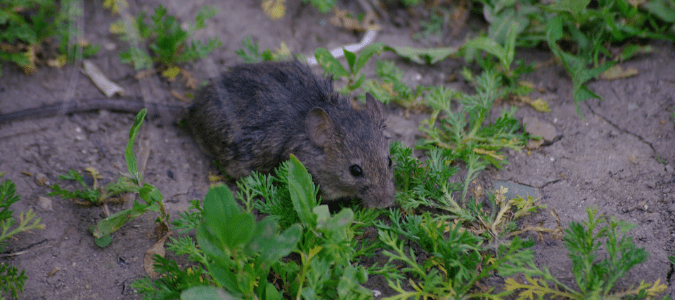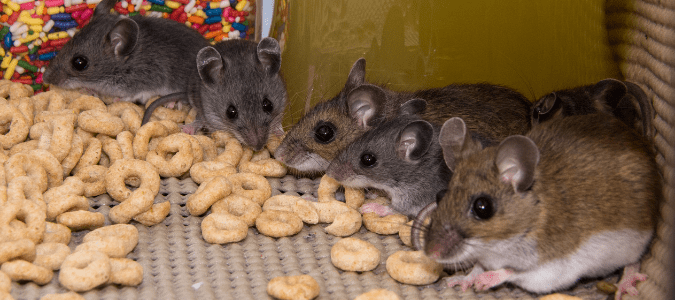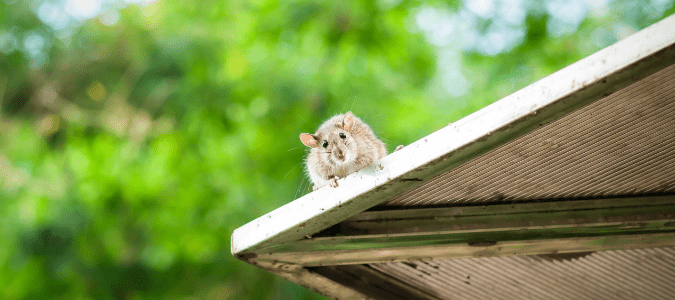
An unfortunate reality of living in the great state of Texas is that we have to worry about many different rodents. If you made it to this blog post, you have probably spotted one. You may even have come to terms with the fact that—much to your dismay—you might have a rodent problem. While some of the most common rodents in Texas are mice and rats, there are also some larger animals you may come across on your property.
Mice And Rats
The three most common types of rodents you’ll see in Texas are the Norway rat, the house mouse and the roof rat. The Norway rat grows to be an average of eight inches in length, with an additional seven inches, when you include the creature’s tail, which is longer than the body. These rodents have brown fur that is often peppered with black, and occasionally a gray or white stomach.
Have you seen rats climbing trees around your home? If this is the case, you may have roof rats. These rodents are excellent climbers, and grow to be about seven inches in length with an additional seven inches of tail. These rodents are usually gray or brown.
The house mouse is the smallest of the three and is also the most common to invade Texas homes. These mice usually gain entry to your home through small openings and crevices that you may not even have noticed. House mice are smaller than rats, only measuring three to four inches in length, with an additional three inches of tail. These mice are usually light brown to dark brown in color, with short hair and sometimes a lighter colored belly.
Tree Squirrels
The three types of tree squirrels that you may encounter include:
- The fox squirrel: This type of squirrel has brownish-gray fur with an orange underside.
- The gray squirrel: As you might suspect, these squirrels are gray in color.
- The flying squirrel: These smaller rodents are brownish-gray across their bodies with a white underside. Broad webs of skin connect their legs, which help them “fly”.
Tree squirrels usually enter your home by climbing tree branches that lead to your roof, then finding or creating holes in your roof to reach your attic, where they build a nest. To prevent squirrels from gaining entry to your home, keep your trees trimmed back at least eight feet from your roof.
Pocket Gophers
While pocket gophers won’t invade the inside of your home, these creatures can damage your lawn by creating craters in the ground. Since they spend nearly all of their time in extensive underground tunnels, gophers can be hard to spot, which makes them difficult to control. In addition to the holes they leave behind, mounds of dirt around tunnel holes can be a sign of gopher activity. Although you may not know how to identify a gopher by sight, if you see a gray, brown, blackish or yellowish rodent emerging from a tunnel, you may a gopher problem.
Nutria
Nutria look similar to beavers and muskrats in appearance, with course brown hair and a rounded tail. These creatures spend most of their time in the water, where they move around thanks to their webbed feet. While there isn’t a high likelihood of a nutria invading your property, you do need to be careful in how you deal with these animals. Nutria are considered fur-bearing animals in the state of Texas, meaning that there are laws in place regarding how to properly trap and remove them from your property.
Porcupines
Believe it or not, these creatures are in the rodent family. While many of us have not seen these animals in the wild, we recognize that porcupines have a distinct look with a back covered in quills. While porcupines are normally content with leaving you alone, if you frighten them or they see you as a threat, they may rub up against you and prick you with their quills.
The type and extent of damage to your home and belongings that these rodents can be responsible for will vary widely, depending on exactly which creature has invaded your yard, attic, garage or crawlspace. If you have noticed one of these animals on your property, and are wondering if there are others you haven’t seen, how can you know if you have a problem on your hands?

Signs Of A Rodent Infestation
When you see a mouse scurrying around your home or yard one day, you may wonder: How many mice is considered an infestation? What if it’s not a mouse, but rather a rat or squirrel that’s been making a nest in your attic?
Quite frankly, it can be difficult for a homeowner to determine whether or not they have an infestation, as not all rodents will be active during the day. If you conduct a quick inspection of your home, however, subtle signs may point to the presence of rats, mice and other types of rodents. Keep an eye out for any of the following signs of a rodent infestation:
- Droppings (which are usually found in pantries, cupboards and around the sink for smaller animals)
- Stale smells or, as rodents start to die, a rotting odor
- Chewed food, packaging, walls or flooring
- Mounds of dirt around the yard
- Tree bark, grass, weeds and other plants that have been eaten or damaged
- Presence of shredded paper or plants that could be used for a nest
- Passages worn down by frequent running or movement
- Squeals, squeaks or scratching sounds
- Odd pet behavior
Among all the rodents we’ve discussed, the rodents that most commonly invade residential areas are rats. But why do these creatures want to live with us in the first place?

What Causes Rats To Come In Your House?
Your home provides a rat with everything it needs: food, shelter and water. This is especially true in the winter months.
While rats don’t mind building a nest and raising their young outside, if they find a way into your home, shed or garage while they are exploring, they might just make your home theirs.
Those aren’t the only parts of your property they may find enticing, either. You could also find rodent activity in and around:
- Electrical, plumbing or sewer lines
- Piles of firewood or lumber
- Junk piles or discarded cars
- Compost piles
Rats and mice aren’t too picky about where they want to live, what they want to chew and what of your belongings to destroy. If they happen to choose your attic or your house and stick around, you’ll need to take action fast.
To make matters worse, rat and mice families grow fast. Mice can produce litters of five to six offspring. In a single year, one mouse can bear up to ten litters. That’s up to sixty offspring in a single year! Many of those babies will be able to reproduce in as little as six weeks.

Rodent Damage: How To Spot It (And Prevent It)
At the first signs of an infestation, you’ll need to take action to prevent further damage. Simply having a mouse in the house may not be a problem. Once that mouse decides to make your home a spot for breeding, however, you will start to see an impact.
Smaller rodents like rats and mice may cause damage in your home by chewing up just about anything. They don’t discriminate as they seek out ways to keep their teeth from growing, which can mean chewing the wood that makes up the foundation of your home, the food that you were planning to eat or the electrical wiring within your home. If you are surprised to hear that rodents can damage wiring, you aren’t alone. Experts believe that one in four fires that have “unknown causes” are caused by rodents.
We haven’t even touched on the damage that larger rodents can do throughout your home or property. Pocket gophers can kill your lawn and garden by feeding on plant roots. The worst part about this kind of damage is a homeowner often doesn’t realize this is going on until plants start dying. Porcupines will eat your grass and plants, and they also have a fondness for wood. They’ll eat trees and stems, and have even been known to munch on other items like canoe paddles when hungry. Nutria eat nearly 25% of their body weight daily. This means these creatures can consume about five pounds worth of your grass, the bark on your trees, flowers and roots every day.
While most of us think of the destructive nature of rodents, these creatures can also pose a health risk in our homes because they can spread diseases to humans through both bites and their bodily fluids. Worse still, these animals can bring in other pests on their fur, including fleas and ticks, and introduce a whole other set of issues.
The best way to prevent rodent damage is by keeping these creatures away from your property.
Rodents And Health Concerns
Unfortunately, as we mentioned earlier, being exposed to rodents can pose a health hazard. Rodents may carry diseases that can be spread to your family or your pet. Additionally, these creatures often bring allergens with them that can trigger asthma or allergic reactions.
Some diseases aren’t directly transmitted by rodents, but by the ticks and fleas that they have introduced to your home and lawn.
Your family and pets could be at risk of any of the following diseases due to direct or indirect contact with rodents:
- Hantavirus Pulmonary Syndrome (HPS)
- Rat-bite fever
- Salmonella
- Tularemia
- Lyme disease
- Relapsing fever
- West Nile virus
- Rabies
In addition to spreading disease, rodents can attack if startled or threatened. This is particularly true of many larger rodents.
Because of the health risks associated with rodent infestations, your best course of action is to bring in a rodent control professional who can properly and safely address your problem.

How To Keep Rodents Away From Your Family And Property
Prevention is the best way to ensure that rodents do not damage your home or spread diseases to your family. Take the following steps to prevent a rodent infestation in your home:
- Seal openings in the foundation or around entrances to prevent any rodents from finding a way into your home
- Stuff holes with steel wool, since mice and rats can’t chew through this material
- Set traps to remove existing rodents
- Store food and other valuable or delicate items properly
- Regularly turn compost piles
- Securely seal garbage bins inside and outside the home
- Bring pet food and water bowls inside at night
Remember, many of these rodents have adapted to squeeze into surprisingly small cracks. Don’t skip over any opening in your foundation or around your windows just because it seems tiny. Complete a thorough inspection of your home and take all appropriate action to prevent a future rodent infestation.
Some homeowners claim that ammonia, peppermint oil and antifreeze are smells that keep rats away and could even potentially poison them. But keep in mind that these substances can also be harmful to your pets and children.
Once you have gotten rid of the rodents on your property, you will need to clean up the area where these animals were living. Doing so can help to prevent further damage and discourage the presence of additional rodents if they can find another way to enter your home. Before you clean the impacted area, ensure you have proper airflow. Ventilation can help to remove any stale smells and prevent traces of the rodents from moving into other parts of your home.
After you clean up rodent droppings or nests, thoroughly disinfect the area. This may include steam cleaning furniture, washing sheets or mopping the area with bleach. These rodents and their droppings may carry diseases, so take the time to get the job done right, or enlist a professional to do it for you.
ABC Can Treat And Prevent Rodent Damage
Rodents are an unfortunate fact of life for homeowners in Texas. These creatures are called pests for a reason, as they are often very hard to get rid of without the help of a professional. The rodent and wildlife removal experts at ABC Home & Commercial Services have extensive experience in helping homeowners deal with even the toughest rodent problems. Our specialists are skilled in locating and removing these animals from your property and making sure you don’t have to deal with any return visitors. With ABC’s help, you can rest easy, knowing your home is protected.
